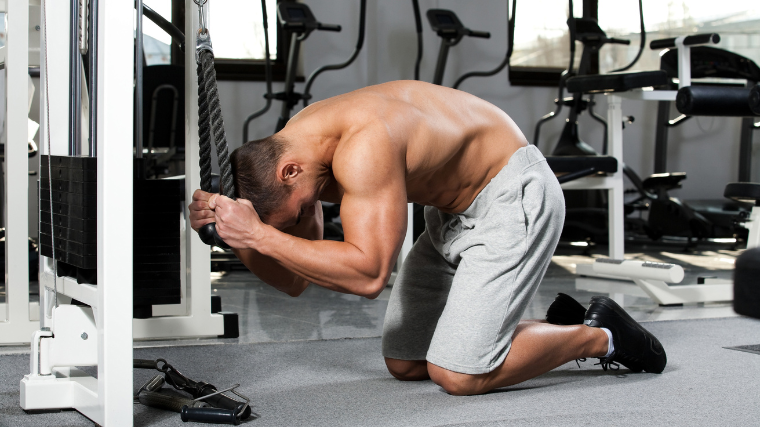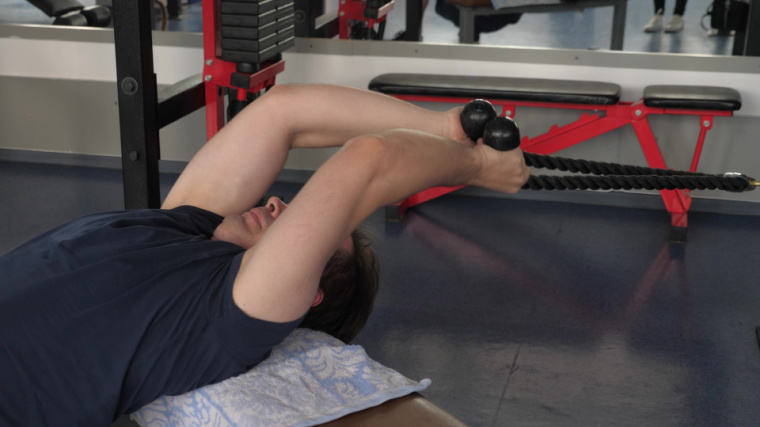The gym offers a diverse selection of training tools to suit your needs. You can make some serious gains using calisthenics, but there’s also free weights, machines, and even cables at your disposal — yet it often seems like abdominal training can be a bit more vanilla by comparison.
When it comes time to build up your midsection, a trusty set of planks or some abdominal crunches can certainly set the stage, but they needn’t always be the main event. Introducing some of the same equipment that makes up the bulk of the rest of your workout can be just as effective as your floor work.

For example, try weaving in some cables into your ab workouts to crush your core with these five workouts:
Best Cable Ab Workouts
- Best Cable Ab Workout for Beginners
- Best Cable Ab Workout for Strength
- Best Cable Ab Workout for Bodybuilding
- Best Cable Ab Workout for Posture
- Best Cable Ab Workout for Balance
Cable Ab Workout for Beginners
Cables offer a great number of options to train your abdominal muscles in ways you may not have been exposed to before if you only use calisthenics. Freedom of movement and scalable loading are for building your base as a beginner.
Try complementing some of your favorite core training basics with some cable-based patterns to introduce yourself to this new style.
The Workout
It’s a good idea to start your abdominal training with the cables — simply getting used to their unique resistance curve can make them seem even more difficult. Lead with a pair of cable exercises to start building up your coordination and strength before dipping your toes back into the bodyweight exercises that you’ve got a bit more experience with.
Over time, you should see some serious gains in skill and stability that will help translate into heavier loads and even more core development.
- Cable Pallof Press: 2 x 10 per side
- Cable Chop: 2 x 10 per side
- Bicycle Crunch: 2 x 10 per side
- Front Plank: 2 x 30 seconds
Cable Ab Workout for Strength
If you train for maximal ab strength, consider your priorities. There is the obvious component of wanting to make your midsection as strong as possible to prevent any folding under heavy weights, but there’s also the benefit of retaining your ability to move into different ranges of motion.
General strength exercises help to train your core by resisting the weight you’re lifting and keeping your torso rigid. Complementing this with movements that encourage you to flex, rotate, or resist different positions can also help offset any mobility restrictions from developing.
The Workout
Many strength exercises such as heavy squats or deadlifts provide a ton of core training themselves. Choosing exercises that challenge you in different planes of motion and actually encourage you to flex your core muscles through a full range of motion (similar to a biceps curl) can help you stay strong and flexible all at once.

To get as strong as possible, make sure you’re utilizing some dynamic abdominal exercises and not just ones that require standstill stability.
- Cable Abdominal Crunch: 2 x 12
- Side Plank: 2 x 30 seconds per side
- Kettlebell Windmill: 2 x 10 per side
Cable Ab Workout for Bodybuilding
Bodybuilding is where cables can really shine for building up your abs. Progressive overload can help guide you to tremendous gains across the board, but it can be a bit more challenging to apply these same concepts to abdominal exercises.
Luckily, you can load up your old favorites with a cable machine and you may find that you’ve discovered the cheat code to crushing your core.
The Workout
Building up your abdominal muscles will follow the same rules as building up any other muscle. You’ll want to take the abs through a full range of motion, slowly add sets, repetitions, or weight, and attempt to get relatively close to muscular fatigue.
- Cable Abdominal Crunch: 3 x 12 – 15
- Cable Side Crunch: 2 x 12 – 15
- Abdominal Vacuum: 2 rounds for max time
Cable Ab Workout for Posture
Improved posture is one of the most frequent goals when designing a solid core routine. While certain compound exercises such as squats, deadlifts, and their variations will usually challenge very similar components of your body to help build up your postural muscles, sometimes those exercises can be overwhelming or just plain uninteresting. Integrating similar challenges using cables and other core exercises can help fill that gap and build your postural strength.
The Workout
Heavy lifting is usually centered upon resisting movement through your core. Postural exercises using cables can be selected to accomplish the same thing. Thinking outside of the box and selecting cable-based exercises that will work the back muscles and integrate core strength to complete them is one of the best ways to get the most out of your postural abdominal training.
Complement them with some tried-and-true exercises meant to resist spinal movement and you should be well on your way to building up your postural strength.
- Straight-Arm Cable Pulldown: 2 x 12, 3-1-1-1 Tempo
- Cable Romanian Deadlift: 2 x 10, 3-1-1-1 Tempo
- Half-Kneeling Single-Arm Row: 2 x 10 per side
Cable Ab Workout for Balance
Your core can perform some pretty impressive feats of strength, coordination, and balance. While calisthenics are often viewed as a low-level form of exercise, the more advanced you get the more they actually find themselves atop the mountain of difficulty.
Technique and practice will certainly be some big drivers in your progress. Cables once again can act as a bridge to build some serious strength and coordination in your quest to become impressively acrobatic.
The Workout
Utilizing more advanced calisthenic techniques paired with some heavy cable work can be a great one-two punch to build up your ability to tackle exercises such as muscle ups, single-arm chin-ups, or push-ups.
For whatever your imagination can concoct or if you have aspirations of gymnast style maneuvering — cables and calisthenic techniques are your best bet. Chip away at technique before brutalizing your midsection for some solid strength work with the cables.
- Toes-To-Bar: 2 rounds, AMRAP
- Lever: 2 rounds, AMRAP
- L-Sit: 2 rounds, AMRAP
- Cable Crunch: 3 x 8
Benefits of Cables
Cables are a fantastic way to manage your progress across many different muscle groups. Cables will allow you to make gains with much less absolute load than other tools, they are incredibly adaptable to your body, and can carry over to many different training goals.
They Don’t Need Much Load
Cable exercises oftentimes require much less absolute load than other training methods. Since they provide semi-stabilized resistance due to their cable and pulley systems, you can get away using less weight and “longer levers” to increase the difficulty of an exercise.
Think about a cable Pallof press — by keeping your arms long and extended throughout the exercise, you can challenge your core without using a lot of weight. The resistance itself is very far from the muscles that are working, making even a light load feel heavy.
While you can absolutely go heavy with cables, it’s not a requirement. Rushing to max-effort movement may also cause you to run into a plateau a bit too quickly.
They Are Highly Adaptable
One of the most highly praised aspects of cable-based training is that it is extremely adaptable to basically every body type. Free weights and machines can place you in pre-defined, on-the-rails movement patterns. It can become a dice roll as to whether or not a particular exercise works well for you.
With a cable system, you can reinvigorate most exercises by creatively manipulating your positioning with the improved maneuverability that the cable machine provides.
They Carry Over to All Goals
Cables work well for just about every fitness goal out there. Training for muscle gain? Cables are one of the most effective ways to isolate a targeted muscle group to the greatest extent possible and apply consistent tension. Training for strength? Cables can complement your big lifts and are excellent for accessory work since they don’t induce much systemic fatigue. The list goes on and on.
Anatomy of the Abs
The abs are a unique muscle group in the sense that they encase nearly the entire front of your torso, but also are layered deep within your trunk. Here’s how it all works anatomically.
Rectus Abdominis
The rectus abdominis are the most superficial (or “top layer”) of your abdominal muscles and are more commonly known as the six-pack. They are the block-like muscles that run up and down the middle of your midsection like a zipper and are responsible for helping you flex the spine (think crunches), or resist hyperextension (think planks).
External Obliques
The external obliques are the other more superficial muscle group that you can pretty easily identify. They are the sides of your midsection that start around your ribs and angle downward towards your pelvis.

Your obliques are responsible for rotational and side flexion movements such as side-bends or side planks.
Internal Obliques
The internal obliques lie underneath the external obliques, making them one of the less visible muscle groups of the core. Still, they are just as important when it comes to stability and posture. They are arranged in the opposite direction as the external obliques and help to brace up your midsection during heavy exercise.
Transverse Abdominis
The transverse abdominis muscle is one of the deepest muscles of your core and plays an important role in lumbopelvic stability. When you bear down during a hard brace (particularly when paired with a breathing exercise or hold), the transverse abdominis will activate to assist in creating a rigid torso and resist errant or unintentional movement.
Serratus Anterior
While more of a shoulder or upper body muscle group than directly core, the serratus anterior helps to add to the aesthetic of the midsection. The serratus anterior can be viewed as the finger-like projections of muscle that you’ll see on the upper part of the ribs and help to complete the overall look of the abs.
Exercises that protract your arm (reaching forward) help to activate the serratus anterior. An example would be a protraction push-up here.
How to Add Ab Training to a Workout Routine
You might view ab training as a necessary evil. Whether you love it or hate it, you should probably include at least a bit of it. Here’s how to mix core work into your fitness regime.
Train Them First
One potential solution is to prioritize your abdominal training if they are a lagging muscle group, an aesthetic, strength, or functionality priority, or if you’re just less likely to train them at all unless you start with them.

Make sure you plan accordingly if you intend to train your abs first as their fatigue may make certain exercises more risky. Heavy squats or deadlifts might suffer if you’re going to train your abs first.
Train Them Last
You’ll also commonly see people perform ab work at the end of their workout. By doing so, you avoid fatiguing your core prior to performing movements that require a fresh and strong set of abs.
That way, you can fully fatigue your core without worrying about the immediate consequences. However, hitting abs at the end of your session means performing ab work while generally tired or perhaps low on stability. You may struggle to properly execute complex or balance-based moves as a result.
Train Them On Their Own
If you really want to prioritize your core work, train abs on their own. Doing so can help you keep your core work performance as high as possible without sacrificing any other aspects of your training due to carryover fatigue. This does, however, require another gym (or home) training day in your schedule.
Get Ab-solutely Shredded
Pouncing on some new training options can be just the ticket for bringing your core game to the next level. This doesn’t mean you need to toss out everything that has worked in the past for these new toys, but weaving in some of the tools available to you is a smart way to continue seeing gains.
Take advantage of the freedom that comes with cable work to attack your abs and smash your core for any goal you can think of. Whether as a stand-alone or to compliment other proven methods — cables can be a fantastic addition to your next core routine.
Featured Image: Skydive Erick / Shutterstock